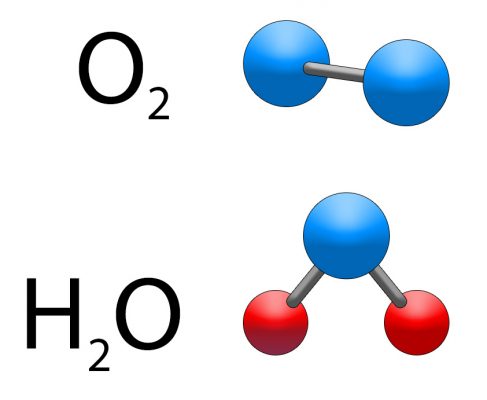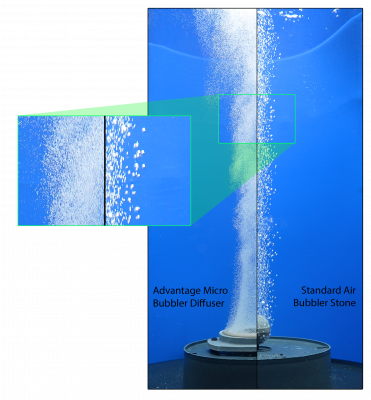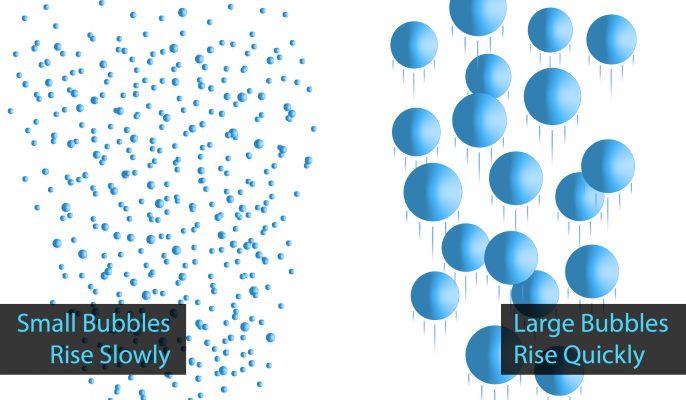The Right Bubbles Lead to the Best Results
One of the most common reasons for losing large numbers of koi all at once in both the wild and in private ponds is a lack of oxygen. Many things contribute to it but the fundamental problem is almost always the same. There is not enough dissolved oxygen available in the water to sustain the whole fish population.
 But you might wonder, if there is oxygen in the air and oxygen in the water (H2O), why is there a problem? The problem lies in the fact that koi can’t breathe oxygen directly from the air because the oxygen needs to be dissolved in the water first so that it can travel through their gills. The problem with the oxygen in the water molecule is that it is bound up with two hydrogen atoms (H2O) which prevents the koi from being able to absorb it. What koi need is pure oxygen in the form of two oxygen atoms bound together (O2). Dissolved oxygen is pure oxygen that is suspended in water and not bound up with any other molecule. This is the oxygen, that when available, keeps fish alive.
But you might wonder, if there is oxygen in the air and oxygen in the water (H2O), why is there a problem? The problem lies in the fact that koi can’t breathe oxygen directly from the air because the oxygen needs to be dissolved in the water first so that it can travel through their gills. The problem with the oxygen in the water molecule is that it is bound up with two hydrogen atoms (H2O) which prevents the koi from being able to absorb it. What koi need is pure oxygen in the form of two oxygen atoms bound together (O2). Dissolved oxygen is pure oxygen that is suspended in water and not bound up with any other molecule. This is the oxygen, that when available, keeps fish alive.
Koi keepers often place air stones in their ponds as a way to increase the dissolved oxygen level in their ponds. This can be effective, however, when applying this technique, let’s consider these 2 important factors:
- Ti
 me of exposure is a measure of how long the oxygen bubble is exposed to the water before it reaches the surface and is lost to the atmosphere. The more time the bubbles of air are in contact with the water, the better the chances are for some of the oxygen contained in the air to transfer into the water as free oxygen.
me of exposure is a measure of how long the oxygen bubble is exposed to the water before it reaches the surface and is lost to the atmosphere. The more time the bubbles of air are in contact with the water, the better the chances are for some of the oxygen contained in the air to transfer into the water as free oxygen. - Bubble size is incredibly important. The surface area of a volume of gas is directly related to its bubble size. For the same volume of gas, for instance, if you reduce the size of the bubbles containing that gas by ten times ( making each bubble ten times smaller and therefore increasing the number of bubbles) you will have increased the surface area of that gas 10 times. By doing this, you will be greatly increase the chances of that oxygen gas being transferred into the water due to the much greater surface area of the gas exposed to the water. Also, keep in mind that because these bubbles are so much smaller, they rise to the surface at a much slower rate, thereby adding to the transfer rate of the gas into the water by increasing the exposure time.
The Advantage Oxygen System is truly in a class all by itself when it comes to increasing the dissolved oxygen in the water of a koi pond for the following reasons:
 1) The Advantage Oxygen System produces 95% pure oxygen as its oxygen source instead of using the ambient air which only contains 21% oxygen. This means that the gas being injected into the pond contains approximately 4.5 times more oxygen as compared to the surrounding air.
1) The Advantage Oxygen System produces 95% pure oxygen as its oxygen source instead of using the ambient air which only contains 21% oxygen. This means that the gas being injected into the pond contains approximately 4.5 times more oxygen as compared to the surrounding air.
2)The Advantage Air Stone reduces the 95% oxygen produced by the generator into bubbles 10 times smaller that an air stone thereby greatly increasing the surface area of the oxygen.
3)Finally, because these 95% pure oxygen bubbles are so much smaller they travel much slower to the surface increasing the contact time.
When you consider the increased percentage of oxygen, the increased surface area of the gas and the longer exposure time to the pond water you begin to understand how this system works. For the first time ever you now have a simple and economical way to bring the saturated oxygen level in your koi pond to whatever level you wish.
Note: We do not recommend taking the saturated level in a pond above 200% of saturation. We have had great success with sustained levels between 120 to 160%.



 me of exposure is a measure of how long the oxygen bubble is exposed to the water before it reaches the surface and is lost to the atmosphere. The more time the bubbles of air are in contact with the water, the better the chances are for some of the oxygen contained in the air to transfer into the water as free oxygen.
me of exposure is a measure of how long the oxygen bubble is exposed to the water before it reaches the surface and is lost to the atmosphere. The more time the bubbles of air are in contact with the water, the better the chances are for some of the oxygen contained in the air to transfer into the water as free oxygen.